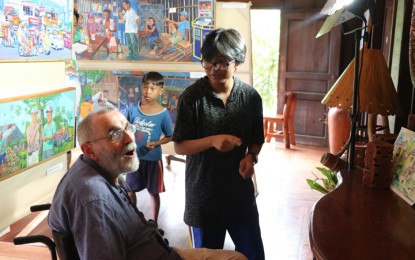
David Joe Brutton, 67, a British cinematographer, introduces paintings as "social documents" in Dapitan City as residents mark the 122nd death anniversary of Dr. Jose Rizal. (Photo by Gualberto M. Laput)
DAPITAN CITY, Zamboanga del Norte -- As Filipinos remember the 122nd death anniversary of Dr. Jose Rizal on Sunday, December 30, a British cinematographer opens his paintings to people of this historically-rich city to show that they do not only promote taste in fine arts but are also unique social documents.
Sponsored by the city tourism office, David Joe Bruton, 67, on Thursday opened a gallery of his paintings here.
Brutton told the Philippine News Agency (PNA) that his paintings attempt to capture some of the energy that characterizes street life in provincial Philippines.
“As a foreigner, everyday scenes that may seem common to Filipinos appear exotic,” Bruton said.
George Aseniero, grandson of Rizal's student Jose Aseniero, told PNA that “(Bruton's) paintings are sociologically meaningful as they depict daily life in Dapitan and Dipolog.”
Bruton explained that his paintings are "generic," although based on photographs and sketches made in the province.
The people who inhabit the paintings are also generic.
"I have not tried to capture the likeness of particular individuals but rather to record a type, displaying typical costume and body language," he said.
Bruton said he is often asked why not paint traditionally beautiful subjects like landscapes or flowers, instead of poverty and common everyday activities.
He said these were the same questions thrown at American artist John French Sloan at the turn of the 18th century, who answered that apart from showing painter's craft, these kinds of paintings are also "unique social documents."
Bruton said his paintings are not political statements since he just wanted to show something extraordinary from the daily ordinariness of life, happiness amid poverty and heroism amid social indifference.
"You cannot find in any part of the West five persons joyfully riding on a (single) motorcycle with a sack of rice," he smilingly said.
Bruton said the quality of the artifact is secondary to the time spent looking at the real motif. And though he used a lot of photographic reference to his paintings, he said he finds it essential to complement it with sketches and studies made from life.
"I spent a lot of time with communities to see and understand the subjects of my paintings," he said.
Bruton arrived in the Philippines in 1979 to shoot an advertisement of a soap manufacturer. Four years later, he married Consuelo Mejia, an international theatrical costumes designer from this city.
He stopped being a cinematographer in 2007 due to his health condition. Bruton has multiple sclerosis.
"I was passionate with cinematography, that's why I have to overcome, to come in terms with it," Bruton recalled.
"I haven't done anything after leaving cinematography until I went back to painting, which I already started when I was 16," he added.
He said painting has somehow helped him through his physical condition. "I like painting, it's stimulating, it's relaxing."
He hopes that by his paintings, he can also show to Dapitanons that there is always life in every tragedy that comes. (PNA)
